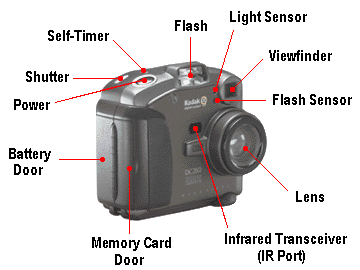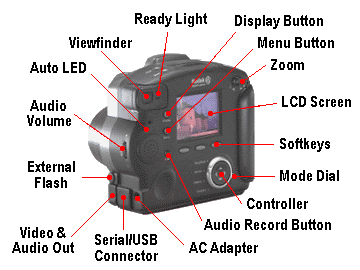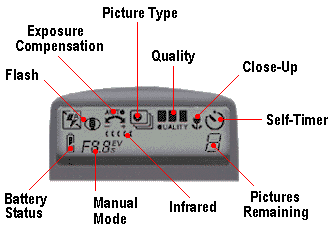A colour LCD panel is a feature that is present on virtually all modern digital cameras. It acts as a mini GUI, allowing the user to adjust the full range of settings offered by the camera and is an invaluable aid to previewing and arranging photos without needing to connect to a PC to do so. Typically this can be used to display a number thumbnails of the stored images simultaneously, or provide the option to view a particular image full-screen, zoom in close and, if required, delete it from memory.
Few digital cameras come with a true single-lens reflex (SLR) viewfinder, where what the user sees through the viewfinder is exactly what the camera’s CCD sees; most have the typical compact camera separate viewfinder which sees the picture being taken from a slightly different angle and suffer the consequent problems of parallax. Most digital cameras allow the LCD to be used for composition instead of the optical viewfinder, thereby eliminating this problem. On some models this is hidden on the rear of a hinged flap that has to be folded out, rotated and then folded back into place. On the face of it this is a little cumbersome – but it has a couple of advantages over a fixed screen. First, the screen is protected when not in use and, second, it can be flexibly positioned so as to allow the photographer to take a self-portrait or to hold the camera above their head whilst still retaining control over the framing of the shot. It also helps with one of the common problems in using an LCD viewfinder – viewing difficulty in direct sunlight. The other downside, of course, is that prolonged use causes batteries to drain quickly.

In a step designed to try to address this problem, some LCDs are provided with a power-saving skylight intended to allow it to be used without the backlight. In practice, however, this is rarely practical. If there is sufficient light to allow the skylight to work, the chances are that it will also render the LCD unusable.
Digital cameras are often described as having lenses with equivalent focal lengths to popular 35mm-camera lenses. In fact, most fixed-length lenses on digital cameras are auto-focus and have focal lengths around 8mm; these provide equivalent coverage to a standard film camera – somewhere between wide-angle and normal focal length – because the imaging CCDs are so much smaller than a frame of 35mm film. Aperture and shutter speed control are also fully automated with some cameras also allowing manual adjustment. Although optical resolution is not an aspect that features greatly in the way digital cameras are marketed, it can have a very important role in image quality. Digital camera lenses typically have an effective range of up to 20ft, an ISO equivalency of between 100 and 160 and support shutter speeds in the 1/4 of a second to 1/500th of a second range.
Digital cameras offer two distinct varieties of zoom feature: optical zoom and digital zoom. Optical zoom works in much the same way as a zoom lens on a traditional camera. Produced by the lens system, it is the magnification difference between minimum and maximum focal lengths. Importantly, in digital cameras this magnification occurs before an image is recorded in pixels. Digital zoom, on the other hand, is arguably little more than a marketing gimmick.
By the early 2000s many digital cameras came equipped with motorised optical zoom lenses which provided an effective range from wide-angle to telephoto. These generally come in a range between 3x and 10x, but it can be higher. The times notation can be confusing, with 3x, for example, having a different precise meaning for different cameras. This is because the actual focal length of a digital camera relates to the size of its sensor. Digital camera specifications therefore generally also cite a 35mm equivalent lens rating. A 3x zoom lens is the standard offering and generally implies an equivalent focal length of some range between 35mm and 140mm. Some cameras have a gradual zoom action across the total focal range, others provide two or three predefined settings.

Digital zoom is nothing more than the cropping of the middle of an image by a digital camera’s software. When an image that has been digitally zoomed 2x is reproduced, either on a display monitor or by being printed, it will effectively be viewed at half its original resolution. A more sophisticated from of digital zoom uses the digital camera’s software to interpolate the cropped image back to its original resolution. In this event, fewer of the original pixels are used to represent the enlarged image, which will appear less sharp as a result. Some digital cameras provide a digital zoom feature as an alternative to an true optical zoom, others provide it as an additional feature.
For close-up work, a macro function is often provided, allowing photos to be taken at a distance as close as 3cm but more typically supporting a focal range of around 10-50cm. Some digital cameras even have swivelling lens units, capable of rotating through 270 degrees and allowing a view of the LCD viewfinder panel regardless of the angle of the lens itself.
Every digital camera has a fully automatic mode metering that allows a user to simply point and shoot. However, in common with traditional film cameras, they also offer a number of different ways of controlling the exposure of an image. A good exposure will result in an image that has balanced contrast and brightness, with no areas that are too bright and washed out or too dark which also creates loss of detail. Center weighted metering is the system used by many digital cameras to measure the correct exposure. With this system, the camera measures the amount of light mostly around the centre area of the lens and less towards the edges. For many situations this works well, but in some lighting situations, centre weighted metering can produce poorly exposed photos. If the scene to be photographed has light areas and dark areas, for example in the shade of trees on bright sunny days with lots of sunlight and shadowed areas, centre weighed metering will often either overexpose the bright sections, or underexpose the dark sections. Some digital cameras offer matrix type metering systems, which break the scene into several areas and measures each individual area’s exposure. This results in an image with a balanced exposure throughout. Spot metering is another option included on some digital camera models. This measures the exposure at a small, precise portion in the centre of the lens, allowing the user to ensure perfect exposure on a particular section of the scene.
Programmed auto-exposure modes keep the basic exposure settings automatic while providing manual access to other camera settings. Some offer aperture- and shutter-priority modes which allow the user to set the f-stop or shutter speed, and then automatically calculate the other settings needed to expose an image correctly.

Some cameras provide a manual exposure mode, allowing the photographer a significant degree of artistic licence. Typically, four parameters can be set in this mode: white balance, exposure compensation, flash power and flash sync. Different types of light (outdoor, fluorescent, and so on) will have an impact on the colours in images. White balance provides a means to correct for the effect of the lighting conditions, such as sunny, cloudy, incandescent or fluorescent. Exposure compensation alters the overall exposure of the shot relative to the metered ideal exposure. This feature is similar to that a SLR cameras, allowing a shot to be intentionally under- or over-exposed to achieve a particular effect. A flash power setting allows the strength of the flash to be incrementally altered and a flash sync setting allows use of the flash to be forced, regardless of the camera’s other settings.
Some cameras offer what is referred to as automatic exposure bracketing. With this, several frames are shot when the shutter is released, each at a different exposure setting. The exposure that gave the best result can then be selected.
Most digital cameras offer a number of image exposure timing options. One of the most popular is a burst mode that allows a number of exposures to be taken with a single press of the shutter. The speed and number of sequential shots that can be captured in a burst is dependent on the amount of internal memory the camera possesses, the image size selected and the degree of compression applied to the photos. Cameras with fast burst rates – specified as a fps rate – generally have a large amount of buffer memory, which is used as a temporarily store prior an image being processed and written to the camera’s primary image storage medium. By the early 2000s, the capability to shoot up to 15 shots in a burst at rates between 2 and 6 fps was fairly typical.
Also common is time-lapse, which delays multi-picture capture over preselected interval. Other examples are the ability for four consecutive shots to each use only a quarter of the available CCD array, resulting in a single frame with four separate images stored on it and to take multiple exposures at a preset delay interval, tiling the resulting images in a single frame.
Features allowing a variety image effects are becoming increasingly common. For example, a user may have the option to select between monochrome, negative and sepia modes. Apart from their use for artistic effect, the monochrome mode is useful for capturing images of documents for subsequent optical character recognition (OCR). Some digital cameras also provide a sports mode – which adds sharpness to the captured images of moving objects – and a night shooting mode which allows for long exposures.
Panoramic modes differ in their degree of complexity. At the simpler end of the spectrum is the option for a letterbox aspect image that simply trims off the top and the bottom edges of a standard image – taking up less storage space in the process. More esoteric is the ability to produce pseudo-panoramic shots by capturing a series of images and then combining them into a single panoramic landscape using special-purpose software.
A self-timer is a common feature, typically providing a 10-second delay between the time the shutter is activated and when the picture is taken and all modern day digital cameras have a built-in automatic flash, with a manual override option. The best have a working range of up to 12ft and provide a number of different modes, such as auto lowlight and backlight flash, fill flash for bright lighting shadow reduction, force-off for indoor and mood photography and red-eye reduction. Red-eye is caused by light reflected back from the retina, which is covered in blood vessels. One system works by shining an amber light at the subject for a second before the main burst of light, causing the pupil to shrink so that the amount of red light reflected back is reduced.
Another feature commonly available with film cameras that is now available on their digital counterparts is the ability to watermark a picture with a date and time, or indeed some other chosen text. And that’s not all. The recent innovation of built-in microphones provides for sound annotation, in standard WAV format. After recording, this sound can be sent to an external device for playback, or played back on headphones using an ear socket. Some cameras even offer an audio made that effectively allows it to be used as a voice recorder.
A couple of other features which demonstrate the digital camera’s close coupling with other aspects of PC technology are a function that allows thumbnail images to be emailed directly by camera-resident software and the ability to capture short video clips that can be stored in MPEG-1 format. Some cameras record silent video only and limit the length of the clips; others sound with the video and allow the clip to be as long as the camera is capable of saving to its storage media.
Borrowing from technology developed for their video camcorder brethren, some digital cameras feature image stabilisation systems. This is particularly useful when used in conjunction with high powered zoom lenses, when it can be very difficult to keep the camera still enough to create a clear image, especially in low light situations and when using a slow shutter speed. Image stabilisation is employed to help overcome the effects small movements of the camera.
Higher-end models also provide support for two memory cards and features more commonly associated with SLR-format cameras – such as detachable lenses and the ability to drive a flash unit from either the integrated hotshoe or an external mount. Indeed, by early 2000 a number of major manufacturers – including Nikon and Kodak – were preparing to follow rival Minolta’s lead in pushing digital cameras into the mainstream professional market by offering single lens reflex technology at affordable prices. While the differential between professional and consumer models remains significant, it decreased dramatically during the late 1990s – as has the gap between digital cameras in general and their analogue counterparts.
- What is CCD in the Context of Digital Cameras?
- CMOS Digital Cameras
- What Controls The Picture Quality of a Digital Camera
- Features and Parts of a Digital Camera
- PIM Technology
- Digital Camera Batteries: Types and How They Work
- Memory Storage
- Storage of Photos and Videos on Digital Cameras
- Digital Camera Connectivity
- Digital Cameras vs. Film
- X3 Technology
- What is PictBridge and PTP?
The content was OK however the pictures were good
im trying to open my camera because the lens seems to be stuck. can someone tell me how ?